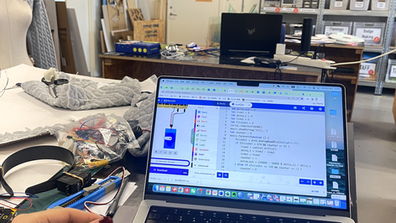top of page


Rabbittude. Wear Your Emotions.
Imagine a world where everyone wore a device that made emotions visible - where feelings weren’t just felt but seen. How would that transform the way we communicate and interact with each other? Rabbittude brings this concept to life. Inspired by animals like rabbits and dogs who express emotions through ear movements, this wearable device reacts to the wearer’s heart rate.
PROBLEM
Human communication is largely dependent on verbal expression to convey emotions. While facial expressions and body language play a role, they are often ambiguous and subject to misinterpretation. Additionally, many individuals find it challenging to articulate their true feelings through words.
SOLUTION
Drawing inspiration from animals like rabbits and dogs, who convey their emotions through visible ear movements, we developed a wearable device that responds to the wearer’s heart rate. Equipped with a built-in pulse sensor, the device detects emotional changes and translates them into real-time visual and physical feedback.
FINDINGS
Participant feedback was overwhelmingly positive, with many highlighting its potential to help individuals express positive emotions they might otherwise struggle to convey.
TIME
1 month
METHODS
Field Work, Scenarios, Crazy 8, MicroBits, Prototyping, User Testing
TOOLS
Figma, Adobe Suite, Miro, Wix, Microbits, Google Workspace, Paper and Scissors.
SKILLS
Interaction Design, Product Design, Design Research, Speculative Design
DISCOVER AND DEFINE
To kick off the project, we employed the "How Might We" (HMW) brainstorming method, along with Crazy 8 and Scenario Development to identify the most interesting direction to explore further.
We started by applying the HMW method to develop four core research questions. To explore each of these, we generated numerous ideas through Crazy 8 exercises and scenario development. After an intense brainstorming session and lots of drawing, we refined our focus and settled on the research question: "How can we explore learning and feedback without verbal communication?"

IDEATE AND DESIGN
During the ideation and design phase, we employed methods such as quick-and-dirty prototyping, explored the capabilities of Micro:bits, conducted rapid testing, iterated on scenarios, and developed both low- and high-fidelity prototypes.
The design phase unfolded in two major stages. During the Quick n' Dirty prototyping were were still exploring various ideas from hand and shoulder pieces to rings and bracelets. Additionally, new ideas emerged when we started experimenting with Micro:bits and its possibilities. Eventually, after testing our prototypes on the body, the concept of Rabbittude emerged. We began to see our prototypes as extensions of the body, conveying signals through light, sound, and movement - forms of communication we often can’t express verbally. Animal-like.

DEVELOP AND REFINE
To transform our idea into a tangible product, we employed various methods, including sketching, low-fidelity prototyping, sewing, coding, and ultimately, the development of a high-fidelity prototype.
The concept of designing rabbit ears emerged from a collaborative brainstorming session, where we explored connections between our research question and the idea of incorporating animal-inspired elements. Considering the limitations of Micro:bits, we designed a solution incorporating a pulse detector to enhance interactivity. When a person's pulse is normal, the ears remain in a neutral position, illuminated by a blue light. If the pulse rises, the ears move, and the light shifts to red, visually reflecting heightened emotion. To hide the battery pack for the ears, we designed a one-sleeve clothing that complements the overall design and makes it easier for us to test the device.
TEST AND CONCLUDE
User tests were conducted with a total of 10 participants in various settings. The tests took place indoors with both familiar and unfamiliar pairs and individually with participants in public outdoor spaces.
Based on numerous user tests, we concluded that a device of this nature could prove valuable in particular situations, such as dating or in a classroom, where it can gauge people's level of engagement and interest.
Participant feedback was overwhelmingly positive, with many highlighting its potential to help individuals express positive emotions they might otherwise struggle to convey. Additionally, they noted its ability to provide clear signals when someone is in distress or simply uninterested.
bottom of page














